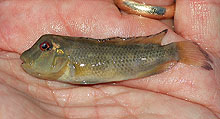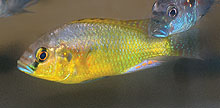Select date in side bar to go to a What's New of previous issues
| What's New
©by Laif DeMason
A record setting warm fall season has already lead us to the “winter” months. No one knows what kind of winter storms will come. But meanwhile, some large hobbyist shows have come and gone. The Aquatic Experience in Chicago and the Ohio Cichlid Association in Cleveland are just two annual events in November. While at Chicago’s event this year, I saw plenty of impressively colored, “designer” Aulonocara peacock types developed in the Far East by commercial breeders. Apparently these fish are widely available in stores and, to say the least, are not like any wild form we know. The purists say “never!”, but I wonder what the purists said when the first black angelfish, Pterophyllum scalare, were bred? Certainly not the wild Amazon form. Right or wrong, this is where the hobby seems to be heading now…all man made varieties! Here’s “what’s new” on the cichlid scene: |
Lake Tanganyika
Collecting and exports of wild Tanganyika cichlids continue from most coasts. Since most fishes are now caught by subcontracted African divers, the variety is limited to easily caught and hardest species from the usual places. All delicate and uncommon forms must be sourced from a limited number of breeders.
 There are still, from time to time, wild Xenotilapia species imported, but some of the favorite, deep, and remote forms remain illusive. Best to source these from breeders, who usually have no problems selling them! Pictured here, Xenotilapia flavipinnis “red fleck” from Kekese, Tanzania. |
 Formerly caught just south of Gombe Stream National Park and at another location near Kigoma, Tanzania, this fish is hard to come by in the wild. So much so that most hobbyists do not even know what this “red” form of Altolamprologus compressiceps looks like! Especially beautiful as adults. |
 The Petrochromis fad continues to challenge hobbyists. Apparently some of the most aggressive P. famula and P. polyodon types are now being passed up. There are some species, however, that are somewhat less aggressive, like this P. fasciolatus from Kekese, Tanzania. Photo by A. Konings. |
 The first variety of Ophthalmotilapia nasuta caught and exported from Burundi by Pierre Brichard decades ago was the “Green Nasutus”. Named after the general body color and to distinguish it from the more yellow types found elsewhere later on, this old relic has captured hobbyists’ attention for the time being. Photo by A. Konings. |
Lake Malawi
Wild caught Malawi cichlids continue to be shipped to hobbyists in the Far East and Europe, but to a lesser degree to the United States due to shipping expense, although several newer forms are collected and exported from time to time. However, both wild and bred natural forms face a big challenge economically from the cheaper “designer” forms from the Far East.
 A not often seen import from near Chipoka, Malawi, has appeared for the first time in years, Aulonocara brevinidus. This small and delicately-colored peacock is something that Malawi hobbyists can really get excited over! Photo by A. Konings. |
 Another incidental cichlid, Placidochromis electra or “Black Face”, is caught near Fort Maguire along Malawi’s eastern coastline. Males tend to have extremely dark coloration on the anterior part of the body, which is quite noticeable even in newly imported individuals. Photo by A. Konings. |
 Every now and then a very large cichlid arrives that has not been imported before. Such an item is this Taeniolethrinops macrorhynchus. Impressive, but definitely one for the Malawi predator specialist! Photo by A. Konings. |
 Recently a new, long-fin form of Protomelas sp. ‘steveni taiwan’ Red has been available from Far East breeders. Note the longer dorsal, anal, and caudal fins on this small adult fish. |
West and Other Africa
As the overall aquarium fish business improves, importers are looking to increase species selections to sell. Some of the not-so-profitable export countries are being sampled for their wares again. Maybe something hobbyists can count on in the future depending on their receptive purchases.
 Formerly imported as contaminants in shipments of Steatocranus causarius from Kinshasa, Congo, one such fish is now selectively sent. Pictured here is S. sp. ‘red eye’ (often sold as S. glaber) from the Kwango River area in Congo. There are now several location names associated with different Buffalohead exports. |
 Not usually seen in commercial exports, some species of riverine cichlids infrequently appear in shipments. Here is such a fish; Astatoreochromis straeleni found it way recently to the USA. This highly-marked yellow cichlid has blue lips and hails from several East African countries. |